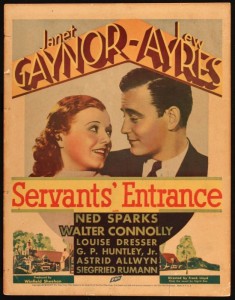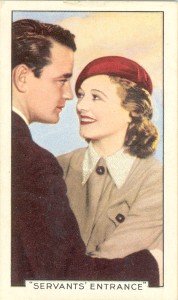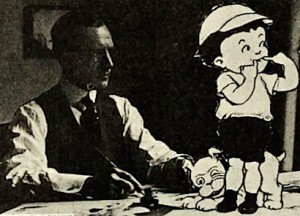The Silly Symphonies have been on my mind a lot lately. Last week I wrote in this department about Hot Chocolate Soldiers (1934), a Disney animated insert in a live-action MGM feature, which wasn’t really a Silly Symphony but which was tangentially related to the series.
 And the tangent didn’t end there. Shortly after completing Hot Chocolate Soldiers, the Disney studio produced another animated insert, this time for a Fox feature titled Servants’ Entrance. Like its predecessor, this second effort was a thoroughly engaging little picture—but quickly fell into obscurity after its initial release. If anything, it has become even more obscure than Hot Chocolate Soldiers.
And the tangent didn’t end there. Shortly after completing Hot Chocolate Soldiers, the Disney studio produced another animated insert, this time for a Fox feature titled Servants’ Entrance. Like its predecessor, this second effort was a thoroughly engaging little picture—but quickly fell into obscurity after its initial release. If anything, it has become even more obscure than Hot Chocolate Soldiers.
 One possible reason for that obscurity: the Disney Servants’ Entrance sequence is not a self-contained episode, but is inextricably integrated with the plot of the feature. It doesn’t quite make sense apart from the feature. Here’s the context: Servants’ Entrance presents Fox star Janet Gaynor as a well-to-do young lady on the brink of marriage. She goes incognito as a maid in a wealthy household in order to prove that she can handle household tasks—but, in fact, kitchen work is more than she bargained for. On her first day in the kitchen she leaves a trail of broken dishes and bent silverware. The Disney sequence depicts her nightmare that night, as the damaged utensils come to life and put her on trial for her crimes against them.
One possible reason for that obscurity: the Disney Servants’ Entrance sequence is not a self-contained episode, but is inextricably integrated with the plot of the feature. It doesn’t quite make sense apart from the feature. Here’s the context: Servants’ Entrance presents Fox star Janet Gaynor as a well-to-do young lady on the brink of marriage. She goes incognito as a maid in a wealthy household in order to prove that she can handle household tasks—but, in fact, kitchen work is more than she bargained for. On her first day in the kitchen she leaves a trail of broken dishes and bent silverware. The Disney sequence depicts her nightmare that night, as the damaged utensils come to life and put her on trial for her crimes against them.
SERVANTS’ ENTRANCE
Layout: Charles Philippi
Animation: Art Babbitt (Judge Egg)
Ed Smith (characters enter from under door, exit back toward door)
Roy Williams (characters climb up foot of bed and dresser; LS crowd scene at foot of bed
as Judge Egg calls for quiet; LS crowd scene as characters start to exit foot of bed)
Archie Robin (mustard pot)
Cy Young (egg beater)
Ben Sharpsteen crew:
Milt Schaffer (mustard pot climbs bedside stand and turns on lamp; singing sugar tongs)
Woolie Reitherman (old broken fork sings solo)
Jack Kinney (singing ensemble on top of dresser; ensemble starts to exit)
Don Towsley (singing knife and nutcracker)
Leonard Sebring (fork quartet; spoon trio)
Earl Hurd (MS of knife and forks in frenzy)
Nick George (CU of knife, forks, and sugar tongs in frenzy)
Louie Schmitt (egg falls and cracks; chick hatches, dances, and crows)
[Babbitt animated all of Judge Egg’s scenes except the LS of the crowd at the foot of the bed as the judge calls for quiet, and the second LS of the foot of the bed, both of which were animated by Williams; and the judge’s fall from the bed, which was animated by Schmitt. Similarly, Robin animated all the mustard pot’s scenes except the character turning on the bedside lamp, which was jointly animated by Sharpsteen and Schaffer.]
Music: Frank Churchill
Voices: Billy Bletcher (Judge Egg)
Pinto Colvig (mustard pot)
Allan Watson (singing knife)
Paul Taylor (singing nutcracker)
Betty Rome (singing sugar tongs)
Sid Jarvis (broken fork)
Spoon trio: Madeline Green
Jean Schock
Helen Jamison
Fork quartet: Henry Schnetz
Austin Grout
Frank Carpenter
Lee Typens
(The crowing chick at the end is a transitional device: in the feature the animated chick cross-dissolves into a live-action crowing rooster, signaling the start of a new day—and a new scene.)
This sequence was produced in the summer of 1934, when the Disney studio was riding a wave of success unprecedented for a cartoon studio. Of course the Disney success story had been building ever since Steamboat Willie, but now Walt was hobnobbing with world celebrities, planning his first feature-length film—and, incidentally, producing special scenes for major studios like Fox and MGM. This sequence, like so many of Walt’s own contemporary cartoons, radiates the excitement of new challenges, of unlimited possibilities.
 Most obviously, there’s the matter of combining animation with live action. Combination scenes were nothing new in themselves, and in fact the Disney sequences for Hollywood Party had featured an onscreen confrontation between the animated Mickey Mouse and the live-action Jimmy Durante. But those scenes, like many others, had been staged against a plain white background, where two elements could be photographically combined with a minimum of difficulty.
Most obviously, there’s the matter of combining animation with live action. Combination scenes were nothing new in themselves, and in fact the Disney sequences for Hollywood Party had featured an onscreen confrontation between the animated Mickey Mouse and the live-action Jimmy Durante. But those scenes, like many others, had been staged against a plain white background, where two elements could be photographically combined with a minimum of difficulty.
The Servants’ Entrance sequence is a different story. Here the studio takes a deliberate stride forward in technical complexity. (Roy Disney later noted that “Walt was intrigued by the idea, and wanted to see what could be done with it; figuring that whatever was worked out would be useful information some time in the future.”) The animated utensils and plates are intricately integrated into the live-action material supplied by Fox, and really seem to be inhabiting the same world that Janet Gaynor does. A portion of the Servants’ Entrance budget was earmarked for the camera department, which specially converted a Bell & Howell camera to bipack operation in order to shoot the trick scenes. The finished animation was combined with the live action by means of the Dunning traveling-matte process. For good measure, some of the live-action scenes were augmented with stop-motion animation of physical props.
I’ve written elsewhere about the writing and development of the Servants’ Entrance sequence, and don’t want to waste this space on recycled text. In any case, Cartoon Research readers may be more interested in a closer look at the animation aspect. Production papers suggest that the animators were supervised by Harry Bailey, who had recently joined the Disney staff after directing cartoons at Van Beuren for several years. Bailey’s supervisory work on Servants’ Entrance may have been regarded as a trial assignment; soon after completing it, he would become part of the original team charged with developing the story of Snow White.
A glance at the animation credits above reveals that the “star” animator here is none other than Art Babbitt—an important Disney team player in those pre-strike days, and concurrently engaged in development of the character we know today as Goofy. His Judge Egg is the most fully realized character in the Servants’ Entrance sequence: pompous and overbearing, resolute in his dignity. Babbitt’s interest in the mechanics of animation, in the depiction of weight and balance, is evident as Judge Egg tries to maintain his precarious balance on the footboard.
And other notable names can also be found in this credit list. Earl Hurd, one of the legendary pioneers of animation in the 1910s (and the creator of Bobby Bumps, soon to be featured on an important new DVD/Blu-Ray), had remained in the animation business and had joined the Disney staff in April 1934. Soon enough he would gravitate to the story department, where he would contribute ideas to numerous Disney films (including Snow White and Pinocchio), but in the summer of 1934 he was working as an animator. We might also note the presence of Nick George, one of the army of lesser-known Disney animators. George contributed isolated scenes to an assortment of Disney films during the 1930s. Today, however, he is perhaps best remembered not for his own work, but as Norm Ferguson’s invaluable assistant—until he moved to the story department himself. These two widely disparate artists, Hurd and George, appear in tandem in Servants’ Entrance, each represented by a single scene.The soundtrack, too, is noteworthy. The great Frank Churchill had just achieved a breakthrough success with “Who’s Afraid of the Big Bad Wolf?” the previous year, and had not yet started on his music for Snow White, at the time he composed the comic-operetta chorus for this sequence. And even the most casual fan will recognize, among the singers, some very familiar Disney voices.
All in all, the Servants’ Entrance sequence is both a delight in its own right and a precious time capsule, a sidelight on the Disney studio at a key moment in its history. For decades it has languished in obscurity—but now, viewed alongside the other Disney classics of 1934, it’s a recaptured gem.
(Special thanks to the staffs of the Walt Disney Archives and Animation Research Library; and to Devon Baxter and Charlie Judkins.)



 J.B. Kaufman is an author and film historian who has published and lectured extensively on Disney animation, American silent film history, and related topics. He is coauthor, with David Gerstein, of the Taschen book “Walt Disney’s Mickey Mouse: The Ultimate History,” and of a forthcoming companion volume on Donald Duck. His other books include “The Fairest One of All,” “South of the Border with Disney,” “The Making of Walt Disney’s ‘Fun and Fancy Free’,” and two collaborations with Russell Merritt: “Walt Disney’s Silly Symphonies” and the award-winning “Walt in Wonderland: The Silent Films of Walt Disney.”
J.B. Kaufman is an author and film historian who has published and lectured extensively on Disney animation, American silent film history, and related topics. He is coauthor, with David Gerstein, of the Taschen book “Walt Disney’s Mickey Mouse: The Ultimate History,” and of a forthcoming companion volume on Donald Duck. His other books include “The Fairest One of All,” “South of the Border with Disney,” “The Making of Walt Disney’s ‘Fun and Fancy Free’,” and two collaborations with Russell Merritt: “Walt Disney’s Silly Symphonies” and the award-winning “Walt in Wonderland: The Silent Films of Walt Disney.”







































I would love to see the complete film. This is a thoroughly delightful sequence–showcases the Disney studio in its prime. It’s nice to see a young Janet Gaynor…singing, no less.
One of the early memos on Snow White suggested that the heroine should be a “Janet Gaynor type.”
Thanks for resurrecting this obscure piece. I hope it gets a full release some time soon.
I’d like to see it too – it looks like it has a good cast, if that poster is any indication: Lew Ayres (later known for the Dr. Kildare film series, from which he would be fired after he declared himself a conscientious objector in WW2), Ned Sparks (who always played dour, scowling, cynical types, and was often caricatured in cartoons), Walter Connolly (a favorite of Frank Capra), and Siegfried Rumann (later known as Sig Ruman).
(1) I was not aware of this insert before; I don’t think any of the major animation treatises had gone into it in detail. I would agree with the comment before me, and your analysis: it’s quite charming, and very effective. Also interesting to hear Vance Colvig’s distinctive voice “in another body.” And Bletcher’s voice is quite familiar – he carries off his role with panache.
(2) Fox Film Corporation (as I think it would have been in 1934, before the merger with Twentieth Century Productions, which off the top of my head happened in 1935 [I checked; the merger was consummated in May of 1935, 8 months after this film was released]) had been very troubled for most of the 1930s. William Fox’s loss of control in 1930, a failed takeover of MGM, and the stock market crash (events tied together) all combined to send Fox into a downturn. Like Paramount, Universal and Warner Bros., it ended up in either retrenchment or receivership, which greatly disrupted production. In the case of Fox, it lead to the Twentieth Century merger. I don’t know how the great vault fire of 1937 might have affected this; that disaster wiped out a great percentage of Fox’s production of the 1920s and early 1930s, and i think was one factor why a number of Fox films of the era can be pretty obscure.
That TCF logo was lifted from another source.
SERVANTS’ ENTRANCE survives intact. It was preserved by UCLA some years back, and was shown in L.A. both by them and at Cinecon. I’m sure it’s played other museum-type venues as well.
JB-
Thank you for this post! This insert is a very delightful one. Gotta love Art Babbit’s animation on Judge Egg.
I would also love to see the full movie of Servant’s Entrance, since I already have watched Hollywood Party long
before J. B. Kaufman wrote about the animated sequence in that movie.
I’ve read that the film “Three is a Family” also has animation by Disney, but I’ve been unable to confirm this, since it’s hard to find. The closest I’ve found are the opening titles, which have a backdrop of still cartoon storks.